
7 minute read
KOs, Fast Lanes, & Vertical Lines
by DESIREE SMITH-DAUGHETY photography by JOSHUA MCKERROW
Jack Frazier stands in the Main St. Gallery wearing a gentle, welcoming smile. He’s recognizably comfortable in his own skin. His eyes twinkle, signaling that he takes life in stride, as he moves with a grace that belies his 94 years.
Advertisement
Frazier can trace his personal history from the Atlantic to the Pacific and back again, though his art career formed a tighter route concentrated in the Eastern United States. His path began in Birmingham, Alabama, his birthplace. When he was nine
In his studio, Painter Jack Frazier demonstrates how he uses a tool to create his work.
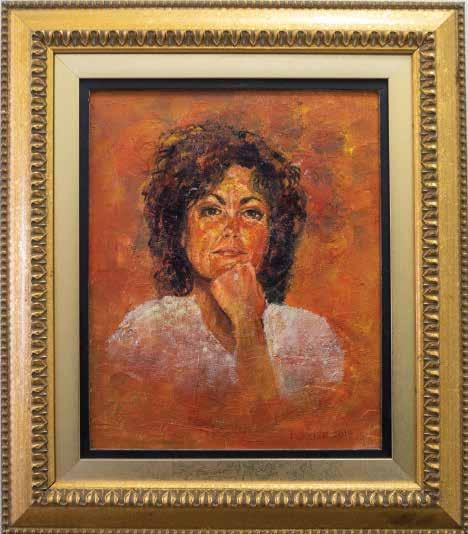
A painting by Jack Frazier of his late wife, Brenda, hangs on a wall in his home.
years old, he entered a soap sculpture competition held at the Alabama State Fairgrounds and won a blue ribbon. He doesn’t recall what the sculpture portrayed, but the piece sat in a glass display case at his school, where it remained for years and was still there when he left. The joy and pride of winning stuck with him.
But his interest in art didn’t fully take root until much later. Frazier moved in wide-ranging directions (both literally and figuratively) that involved, among other things, time as a boxer, entering military service, and becoming a Porsche race car driver, before launching into art.
Frazier began boxing when he was around 12 years old. He boxed in Golden Gloves, an association devoted to amateur boxers, for about four years. “I was pretty successful at it,” he recalls. “I lost one match and found out my coach had bet on me. I felt bad about that!”
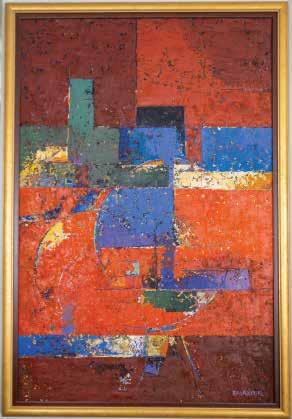
A work by painter Jack Frazier that hangs in his home.
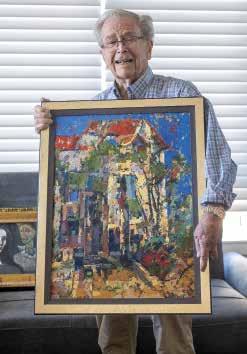
When he was 17 years old, Frazier entered military service with the US Navy. He’d taken a Navy recruiter’s test and qualified for flight school. But he felt that there were people more qualified than he was to fly planes, so he didn’t apply for flight school and instead opted for gunnery school and radio school. With World War II raging, Frazier became a crew member on a torpedo bomber: a single engine airplane large enough to carry a huge torpedo, bombs, a pilot, a gunner, and a radioman. Frazier operated the radio and radar and set the torpedoes.
During his service, Frazier boxed onboard ship where a boxing team had formed and would challenge teams on other ships to matches called smokers. “I don’t know why it was called that,” he says. “Maybe because everyone was puffing on cigarettes.” After he served on four ships, the war ended and Frazier’s squadron broke up. His group was later approached to join a ship—the Curtis Bay—heading into the Pacific: Hawaii, Japan, and China. For Frazier, it was no more than an overseas voyage; having been trained in radio and radar, he didn’t have duties such as swabbing the deck or carrying food. He had plenty of time to get in shape between the ship’s stops at ports along the way. Frazier was particularly struck by Okinawa, Japan, a major battle site in the Pacific Theater. “Got there right after the war was over, it was a wreck,” he says. “There were skulls laying out, everything was bombed and
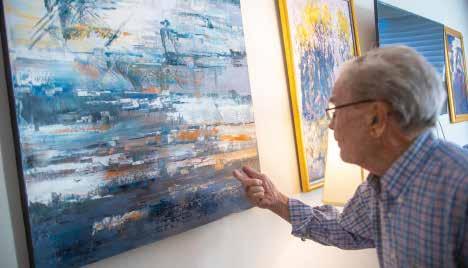
strafed—it was pretty bad. There were airplane parts all over the beaches.”
After being discharged from the military, his art career began in earnest, with formal education. He graduated from a three-year course at a time when Washington, DC, clanged with the sound of streetcars; that’s what Frazier rode, stepping off at a stop three blocks from what he recalls as the National Art School on 19th Street and Massachusetts Avenue.
“Afterward, I thought life would be fast cars, fast women, and wads of cash—but that didn’t work out!” says Frazier, laughing at his youthful exuberance and outlook. But art didn’t bring him the anticipated wonders of his starryeyed youth. He realized that he had to get a different kind of job.
He landed at the Pentagon, working for the US Army chief of staff, flying everywhere across the United States and into Canada. He remembers his years there with fondness, with myriad projects
Jack Frazier checks to see if a new painting is still wet.
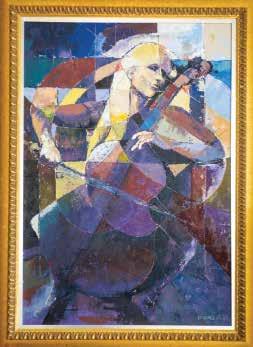
A work by Jack Frazier.
to work on that lasted about two weeks before the next one began. During his time with the Chief of Staff, he made friends, and he made professional contacts with different companies making war goods, which later came in handy for his post-military service work.
In 1959, Frazier bought a red Porsche Speedster, inspired by his first visit to a racetrack with his lieutenant commander from the Navy, who had gone there to race. “I got the bug when I went to the track. It looked like a lot of fun,” he says. After attending racing school and completing many races at different tracks, he qualified to become an instructor. Frazier taught at a racing school, which enabled him to drive a variety of cars. The school also held special events, such as one for children with health problems who were taken for a spin around the track in a race car. Frazier also served as president of the Washington, DC, Porsche Club—the first one in the country. He raced locally on and off for years, both for a Porsche car dealership and for himself, driving his own car. “I flushed a lot of money down the toilet, and it was fun,” he says of his racing years.
After shifting to selfemployment, doing analytical consulting work, Frazier obtained a contract with the British Oil Association—a contact from his Pentagon days—and worked on an as-needed basis. The work amounted to roughly four months per year, which gave Frazier time to focus on his artwork. He has enjoyed 20 years of steady painting, with over a dozen solo shows to date. His first show was in Washington, Virginia, at the Packing Shed Gallery. Other shows took place in towns such as Easton and Annapolis.
For 20 years, Frazier lived in Annapolis. He then moved to Virginia, near the Blue Ridge Mountains, to a home with acreage. “We had flower beds, vegetable gardens—plenty of room,” he explains. He also had art shows in Warrenton, Virginia.
He returned to Annapolis, where his two sons and their daughters now live. He’s able to see his four grandchildren regularly, as they are within walking distance of Main St. Gallery, where Frazier has displayed his work for the past five years. Margaret Lee, artist and owner of the gallery, has lent him a guiding hand in the business aspects of selling art.
Frazier’s current works, on display throughout the gallery, are abstracts, featuring strong lines that hint of objects or leave the visual just fluid enough for viewers to interpret what they will. Though the works are abstract, they exude form and structure; perhaps his former military and boxing training exert their influence in the oil paints he applies to the canvas. He credits being heavily influenced by the works of German painter Gerhard Richter, whom Frazier says is considered a top-selling living artist. Frazier was viewing the works of abstract painters online when he came across Richter, who has used a squeegee to paint. “I don’t use anything like that,” he says. “I use a huge palette knife on some paintings, and use a regular one on about 90 percent of my paintings. I use his technique in a small way.”
Unlike Richter’s expansive canvases, Frazier works on more compact sizes. “I pull the paint vertically, rather than horizontally, the way Richter had space to do,” he says, demonstrating with a hand-to-hand measurement to indicate roughly a half-foot’s width.
He works out of an in-home studio and shows his work consistently at Main St. Gallery. Speaking highly of Lee, he credits her for giving him the idea to add some lighter pieces in terms of color values. One such work is displayed prominently in the gallery’s front window.
“As soon as he came in, he started selling almost immediately,” says Lee. “People just love his work—they see things in his work, shapes and forms. It elicits a curiosity in them that’s amazing. A wonderful addition to the gallery!”
Considering his 94 years on this earth, Frazier says, “I’ve always been active, looking for something interesting to do. I’m not as active now, so painting suits me just fine. It’s not like boxing or racing, that’s for sure!” █








